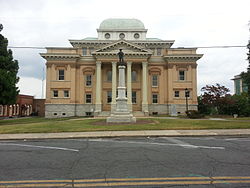2020 census
As of the 2020 census, there were 144,171 people and 57,470 households in the county, including 37,795 families residing in the county. [34] [1]
The median age was 42.4 years. 22.1% of residents were under the age of 18 and 18.9% of residents were 65 years of age or older. For every 100 females there were 97.0 males, and for every 100 females age 18 and over there were 95.1 males age 18 and over. [34]
The racial makeup of the county was 77.3% White, 6.1% Black or African American, 0.8% American Indian and Alaska Native, 1.5% Asian, <0.1% Native Hawaiian and Pacific Islander, 7.5% from some other race, and 6.8% from two or more races. Hispanic or Latino residents of any race comprised 13.2% of the population. [35]
39.8% of residents lived in urban areas, while 60.2% lived in rural areas. [36]
There were 57,470 households in the county, of which 29.9% had children under the age of 18 living in them. Of all households, 49.6% were married-couple households, 18.2% were households with a male householder and no spouse or partner present, and 25.9% were households with a female householder and no spouse or partner present. About 26.9% of all households were made up of individuals and 12.5% had someone living alone who was 65 years of age or older. [34]
There were 62,024 housing units, of which 7.3% were vacant. Among occupied housing units, 72.2% were owner-occupied and 27.8% were renter-occupied. The homeowner vacancy rate was 1.2% and the rental vacancy rate was 6.2%. [34]
2000 census
At the 2000 census, [37] 130,454 people, 50,659 households, and 37,335 families resided in the county. The population density was 166 people per square mile (64 people/km2). The 54,422 housing units averaged 69 units per square mile (27 units/km2). The racial makeup of the county was 89.20% White, 5.63% Black or African American, 0.45% Native American, 0.64% Asian, 0.02% Pacific Islander, 3.01% from other races, and 1.06% from two or more races. About 6.63% of the population was Hispanic or Latino of any race.
As with much of North Carolina, the Latino population of Randolph County continued to grow into the 21st century. In 2005, figures placed the Latino population as 9.3% of the county's total.
In 2000, of the 50,659 households, 33.70% had children under the age of 18 living with them, 59.10% were married couples living together, 10.20% had a female householder with no husband present, and 26.30% were not families. About 22.50% of all households were made up of individuals, and 8.60% had someone living alone who was 65 years of age or older. The average household size was 2.55 and the average family size was 2.97.
In the county, the population was distributed as 25.00% under the age of 18, 8.00% from 18 to 24, 31.30% from 25 to 44, 23.50% from 45 to 64, and 12.10% who were 65 years of age or older. The median age was 36 years. For every 100 females, there were 97.80 males. For every 100 females age 18 and over, there were 95.40 males.
The median income for a household in the county was $38,348, and for a family was $44,369. Males had a median income of $30,575 versus $22,503 for females. The per capita income for the county was $18,236. About 6.80% of families and 9.10% of the population were below the poverty line, including 11.60% of those under age 18 and 11.50% of those age 65 or over.






